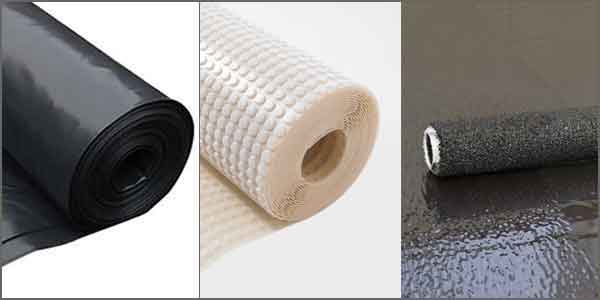The DIY Fix is reader supported. When you buy after clicking a link on our site, we may earn an affiliate commission.
A damp proof membrane is a watertight, moisture-inhibiting material. They are effective at stopping different types of damp for entering the home.
Damp proof membranes are usually used in two main areas. These are the walls and floors of a property. Due to this, they are effective at protecting against rising damp and penetrating damp.
Different Types of Damp proof Membrane

There are several different types of damp proof membrane.
First, there are membranes that are used underneath concrete floors. These are typically a series of smooth sheets of plastic, usually black, that form a barrier to prevent rising damp.
Different types of membranes are used for walls. These are usually clear or white in colouration and have raised bumps. They are often used in places like basements and are primarily used to stop penetrating damp. This type of membrane is installed differently. It is generally fixed to the walls with screws, washers, and waterproof sealant.
Finally, there are liquid damp proof membranes. These are applied over existing flooring and are used to stop rising damp. This is a convenient and effective way to damp proof existing surfaces.
Damp proof Membranes for Floors
Damp proof membranes installed in floors are usually fitted during the building process.
Starting at one end of a room, the membrane is unrolled, cutting it to fit the room. For larger spaces, additional sheets of membrane are rolled out overlapping the previous sheets. At the joints, waterproof tape is used to seal them together. This process is repeated until you have covered the entire area. It is also possible to join a floor membrane to a wall membrane, to add additional protection
Once the membrane is installed correctly, and the entire floor area is covered, concrete can be poured over the damp proof sheeting. Often a layer of insulation will be installed between the DPM and the concrete. Once the concrete is set, it can be finished with a screed before flooring is installed.
Installing Damp proof Membranes on Walls
Damp proof membranes used on walls, are a different material, and they are installed differently too. The membrane needs physically fixing to the walls to hold it in place.
To install a wall membrane, you first need to prep the surface. To do this, remove any loose or flaking plaster from the wall, this will ensure a clean and flat surface. Cut the membrane sheet to the desired size and place it on the wall. Make sure it folds around corners and has no wrinkles.
Next, the membrane is fixed to the wall using a drill. Once holes are drilled, you can fix in place with specialist waterproof sealing plugs. This will secure the membrane in place and provide a completely watertight surface.
This process needs to be done properly. The membrane will only be effective if it is fitted correctly. This means the fixings should be secure, and there should be no gaps where water could penetrate through
What is Liquid DPM, and Where is it Used?
Liquid DPM is used to protect floor coverings from rising damp and residual moisture from construction. It is used where the typical DPM is either damaged or unviable.
The liquid membrane forms a tight seal, which is usually just as effective as a physical membrane. As the membrane dries, it creates a permeable surface which allows moisture to evaporate in a controlled fashion.
It’s important to make sure that the liquid damp proof membrane successfully adheres to the base layer; otherwise, the performance will be impacted. Careful preparation is required to make sure this is successful. The liquid should be applied evenly across the surface, be free of holes, and be finished at the correct level of thickness.
There are two primary types of liquid DPMs. The first is mastic asphalt. This is the earliest variant of a liquid DPM, it is usually laid on top of an existing membrane. The only drawback of asphalt is that it can become more brittle and liable to cracks over time. In areas where heavy traffic occurs, membranes can receive substantial damage.
The second type of membrane is epoxy resin. This is a newer type of membrane and is the result of advancements in this field. It is a membrane that will adhere well to most base surfaces. This means moisture can successfully evaporate, without causing damage to the surface flooring.
Some common Uses
A common use case for liquid membranes, is in existing constructions. For example, buildings that were constructed pre-1970s. During that time, the inclusion of damp membranes was not standard practice. Since this time, sheet membranes have been used in the construction of new homes. Also, liquid DPM is often used in commercial settings.
The demand for better damp prevention has grown over the years. This is one of the reasons liquid DPM’s have emerged as a more advanced and popular solution.
Conclusion
Damp proof membranes are installed in all new properties as a way of protecting from damp. The most common type of DPM is installed during the building process. This is added at ground floor level and is generally covered with concrete. When this is missing a liquid DPM offers a good alternative for protection against rising damp.
Other types of damp membrane can be installed on walls and in areas underfloor level. This includes areas such as basements, or anywhere there is high exposure to external damp. This type of membrane provides an effective barrier to stop damp penetrating from outside.


